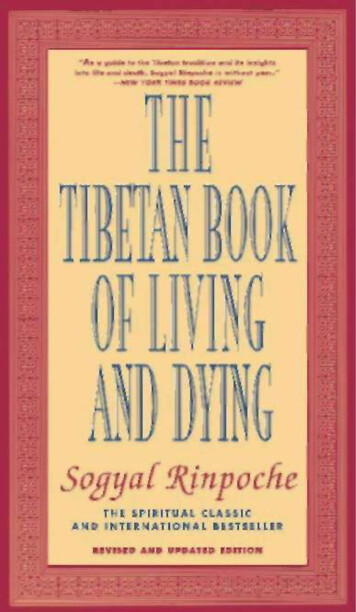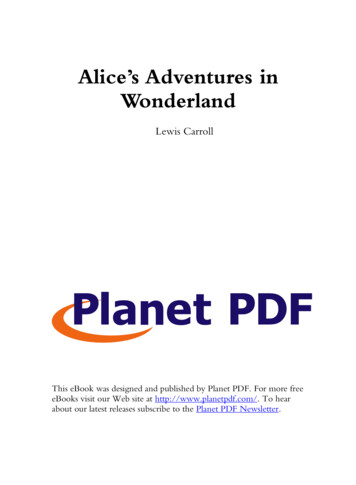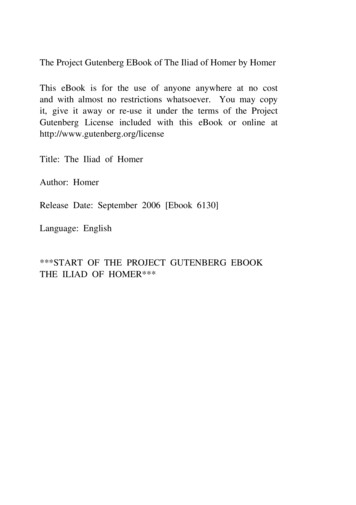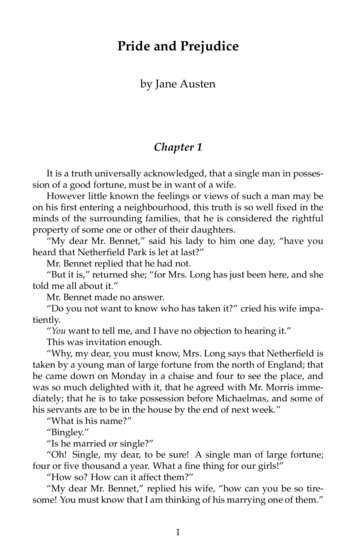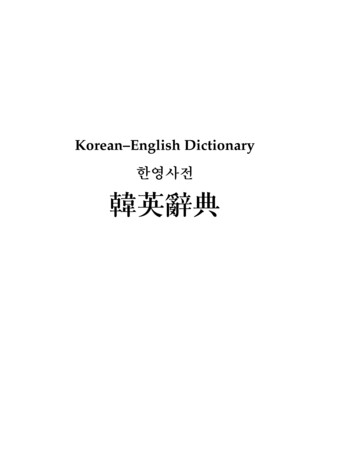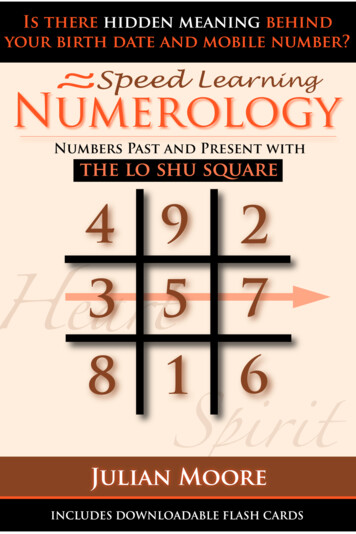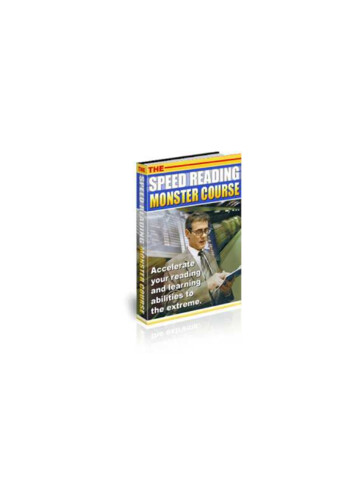
Transcription
The Speed ReadingMonster CourseBy Rie BustenBrought To You ByMIND BODY SPIRIT SITESEnhance Your Mind-Body-Spirit Connectionhttp://www.mbssites.com2 Mind Body Spirit Siteshttp://www.mbssites.com
DISCLAIMER AND TERMS OF USE AGREEMENTThe author and publisher have used their best efforts in preparing this report. The author and publishermake no representation or warranties with respect to the accuracy, applicability, fitness, orcompleteness of the contents of this report. The information contained in this report is strictly foreducational purposes. Therefore, if you wish to apply ideas contained in this report, you are taking fullresponsibility for your actions.EVERY EFFORT HAS BEEN MADE TO ACCURATELY REPRESENT THIS PRODUCT ANDIT'S POTENTIAL. HOWEVER, THERE IS NO GUARANTEE THAT YOU WILL IMPROVE INANY WAY USING THE TECHNIQUES AND IDEAS IN THESE MATERIALS. EXAMPLES INTHESE MATERIALS ARE NOT TO BE INTERPRETED AS A PROMISE OR GUARANTEE OFANYTHING. SELF-HELP AND IMPROVEMENT POTENTIAL IS ENTIRELY DEPENDENT ONTHE PERSON USING OUR PRODUCT, IDEAS AND TECHNIQUES.YOUR LEVEL OF IMPROVEMENT IN ATTAINING THE RESULTS CLAIMED IN OURMATERIALS DEPENDS ON THE TIME YOU DEVOTE TO THE PROGRAM, IDEAS ANDTECHNIQUES MENTIONED, KNOWLEDGE AND VARIOUS SKILLS.SINCE THESEFACTORS DIFFER ACCORDING TO INDIVIDUALS, WE CANNOT GUARANTEE YOURSUCCESS OR IMPROVEMENT LEVEL. NOR ARE WE RESPONSIBLE FOR ANY OF YOURACTIONS.MANY FACTORS WILL BE IMPORTANT IN DETERMINING YOUR ACTUAL RESULTS ANDNO GUARANTEES ARE MADE THAT YOU WILL ACHIEVE RESULTS SIMILAR TO OURS ORANYBODY ELSE'S, IN FACT NO GUARANTEES ARE MADE THAT YOU WILL ACHIEVEANY RESULTS FROM OUR IDEAS AND TECHNIQUES IN OUR MATERIAL.The author and publisher disclaim any warranties (express or implied), merchantability, or fitness forany particular purpose. The author and publisher shall in no event be held liable to any party for anydirect, indirect, punitive, special, incidental or other consequential damages arising directly orindirectly from any use of this material, which is provided “as is”, and without warranties.As always, the advice of a competent professional should be sought.The author and publisher do not warrant the performance, effectiveness or applicability of any siteslisted or linked to in this report.All links are for information purposes only and are not warranted for content, accuracy or any otherimplied or explicit purpose.3 Mind Body Spirit Siteshttp://www.mbssites.com
FEATURED PUBLICATIONBY MBSSITES.COMANCIENT KEYS OF JOYDiscover The Ancient Secrets of Authentic Happiness!http://www.ancientkeysofjoy.comYou CAN Achieve Your Goals-and Live a More Relaxed, Enjoyable Lifestyle - Just By ChangingYour Way of Thinking!Inside each of us are the keys to achieving our innermost desires-fromprofessional goals to personal objectives. Ancient Keys of Joy, fromself-development author Tomislav Tomic, reveals the remarkablypowerful, age-old-yet simple-techniques for realizing your fullestpotential. And best of all, these incredible tools won't require more than20 minutes a day to help you re-frame your worldview, so that you canactually attain the reality you desire. You'll learn:- The groundbreaking science that outlines how your thinking andoutlook affects your physical reality-and how to harness thisextraordinary power.- Why you should reprogram your old, worn-out beliefs to help put youon the path you truly desire and deserve.- The top 3 mistakes most people make that prevent them from achieving their dreams and how toavoid them.- Why just 20 minutes of meditation a day can help you become aware of and unlock the unlimited joywithin.- A complete, step-by-step guide to meditation, perfect for beginners.- The secret for creating time for yourself and achieving a more relaxed state, every day.- Much, much more!Concise, approachable, and always easy to understand, Ancient Keys of Joy is the antidote to ourharried, stressful, and go-go modern lives.Tomislav Tomic is a lawyer, entrepreneur, and author. A practitioner of yoga and meditation since hewas 18, Tomislav has spent countless hours researching these topics and has been taught by respectedexperts. He is a graduate of the law school at the University of Zagreb (Croatia), and lives with his wifeand daughter on the island of Hvar, Croatia.For more information visit http://www.ancientkeysofjoy.com4 Mind Body Spirit Siteshttp://www.mbssites.com
Table of ContentsIntroduction7Pre-Requisites of Speed ReadingChapter 1: Before Speed Reading9Consider Your PurposeLook for Specific WordsBecome an Impatient ReaderDifferent Speeds for Different MaterialsPractice ActivityThe First Step in Speed ReadingSpeed Reading TipsKnowing How Deeply To Study the MaterialChapter 2: How People ReadShort ExercisePay AttentionReducing Fixation Time for Speed ReadingSpeed Reading TechniquesRelationship between Reading Rate and ComprehensionReducing Skip BacksFive Types of Reading1. Skimming2. Scanning3. Light Reading4. Word by Word Reading5. Reading to Study5 Mind Body Spirit Siteshttp://www.mbssites.com15
Chapter 3: Radically Increasing Your Reading Speed24Technical IssuesSelf-Pacing Techniques in Speed ReadingThe Hand TechniqueThe Finger TechniqueThe Card TechniqueThe Sweep TechniqueSpeed Reading TipsWhat Causes Slow Reading?Tips for Increasing Reading RateChapter 4: Suggestions for Increasing Speed and Effectiveness32Major Causes of Slow Reading SpeedWhere to Begin . with Your Next Reading AssignmentEffective Reading MethodsReading Daily News MethodReading Newspapers MethodClose Reading MethodExploratory Reading MethodReading to Learn MethodActive Reading MethodChapter 5: Human Mind and Vocalizationsub-vo-ca-li-za-tionSubvocalization is a NecessitySubvocalization: Good or Bad?Eliminating Subvocalization to Increase Reading SpeedDo you Vocalize Words in Your Mind?Eliminate the Habit of Pronouncing Words as you Speed Read6 Mind Body Spirit Siteshttp://www.mbssites.com40
Stop Talking to Yourself When You Speed ReadChunk Four WordsUse of a Pen or FingerChapter 6: Getting the Main Idea47Extracting Important DetailsHow “So What” Questions Help in Speed ReadingBe an Active ReaderAnswer the Questions at the End of Each ChapterQuestion while you are SurveyingReading CriticallyRecite After Each SectionTips for Developing Good EyesightSpeed Reading CalculatingDouble Your Reading SpeedConclusionFeatured publication7 Mind Body Spirit Siteshttp://www.mbssites.com5860
IntroductionPre-Requisites of Speed ReadingAlvin Tofler, author of Third Wave, contends that we are now in the information age. It is saidthat power belongs to those who have the knowledge and information. This we would like to dispute.Being in the information age, so many data and inputs are available. Tons and tons of materialsare readily available with just one click of the mouse. Numerous data are readily available to all people.Yet, how come not all of these people who have access to mountains of materials are consideredpowerful?It is our contention that those who are able to wade through tons of information, comprehend,and make use of that knowledge for meaningful purposes IN A SHORTER PERIOD OF TIME are theones who hold the key to power. Speed is the key.This reality reinforced the need to update our skills in speed reading. The need to accelerate ourreading and learning abilities to the extreme resulted to this book. This book offers techniques that youcan make use to hasten the skill in reading and comprehension. It presents scientific explanation on thecauses of slow reading. It explains how the practice of hearing your “inner voice” actually saying thewords you are reading can drastically slow you down.Speed reading basically covers two areas: reading and comprehension. These go hand in hand.It is useless to study speed reading if you have trouble in absorbing information. You should already bean able reader before you try to speed read. Speed reading will not help you if you have problems inunderstanding the meaning of the words. To be able to enjoy the full benefits of speed reading, youmust have the necessary facilities in understanding college-level materials.8 Mind Body Spirit Siteshttp://www.mbssites.com
Before starting on speed reading exercises, you must have the condition of your eyes checked.You might want to adjust your reading glasses. Speed reading will “exercise” your eyes, and would notunduly strain them and hamper your improvement. Consult the eye doctor for possible advice on howto take care of your eyes. They will provide advice on the best position while reading, proper positionof the lamp or light source, what to do when you experience eye strain, etc.Apart from these, the speed of learning speed reading (excuse the pun!) is heavily dependent onfour other factors. Ask yourself these important questions: Why do you want to improve your reading? The purpose determines the motivating factors thatwill inspire you to go through and complete the whole program. How much do you want to improve? Do you want to increase it from 300 words per minute to800 wpm then to 1,000 wpm? You have to set a target to be able to determine the extent of yourgrowth. How much time do you have for the exercises? Practice make perfect. It is not enough for youto know the skills, but you should devote time to practice and upgrade your skills faster. How open are you to new techniques? This report requires you to have an open mind to be ableto see and recognize the usefulness of new and scientific techniques in speed reading. Thisreport incorporates new practices such as reading a report from the computer.It is said that speed readers are considered impatient readers. So, what are you waiting for? Letthe lessons begin 9 Mind Body Spirit Siteshttp://www.mbssites.com
Chapter 1Before Speed ReadingHow many times have you promised yourself to read more but just never found enough time?If only you could do it quickly and more efficiently.Effective and efficient readers learn to use many styles of reading for different purposes, whichinclude skimming, scanning, and critical reading. Before reading, you need to identify the purpose whyyou’ll be doing such activity: Are you looking for background information on a topic you know a littlebit about already? Are you looking for specific details and facts that you can marshal in support of anargument? Are you trying to see how an author approaches his topic rhetorically?It is crucial to know your purpose in reading as it helps focus your attention on importantaspects of the text. Before turning those pages, take a moment first to reflect and clarify what your goalreally is.There are many ways to familiarize your self with the background of the text, and gain a usefuloverview of its content and structure before actually absorbing and digesting the text. Seek informationabout the context of the reading, its purpose, and its general content. Look for an abstract or an author’sor editor’s note that may precede the article itself. Read any background information that is available toyou about the author, the occasion of the writing, its intended audience, and more useful information.After viewing the title and noting general ideas that are accessible to you as a reader, you cancontinue to browse pages and scan paragraphs in order to get the gist of what material the text coversand how that material is arranged. As soon as you finished looking over the text as a whole, read theintroductory paragraph or section, noticing that some authors will provide an overview of their message10 Mind Body Spirit Siteshttp://www.mbssites.com
as well as an explicit statement of their thesis or main point in the opening portion of the text.Considering the background information, the messages conveyed by the title, note or abstract,and the information from the opening paragraph or section, you should be able to proceed with a goodhunch of the reading material’s direction.In order to become aware of your reading situation, ask yourself questions like: What do I want (or need) to know and learn? In which context do I want (or need) this? Which texts could suit these needs? What made me choose this text? How deeply an understanding of the text do I need? How much time have I got? How do I want to proceed?Consider Your PurposeTo help you determine a purpose, consider the following ideas: Are you looking for brief information, main ideas, complete comprehension, or detailedanalysis? How will this text help you? Is this the best material to meet your goals?11 Mind Body Spirit Siteshttp://www.mbssites.com
What does background or summary information provided by the author or editor predict the textwill do? Does there seem to be a clear introduction and conclusion that can be useful? Where? What claims does the author make at the beginnings and endings of sections? Are there key words that are repeated or put in bold or italics to help you skim and scan? What kinds of development and detail do you notice? Does the text include statistics, tables, andpictures or is it primarily prose? Are names of authors or characters repeated frequently?Look for Specific Words Scan a section for key words. Skim to the words that provide meaning and may be useful for you and your purpose.Become an Impatient ReaderSpeed readers are considered impatient readers. They read with a purpose and want to findanswers immediately. They can’t wait to find out what the whole text is all about that they usuallymake predictions and guess the answers.Some readers say, "If I think ahead while I am reading, my predictions may be wrong."The truth is, predicting is useful because all your concentration is focused on the reading andyou are actually making senses of it. Speed readers predict what the text is likely to tell them next, butthey are not upset if a prediction is wrong; they quickly adjust their expectations.12 Mind Body Spirit Siteshttp://www.mbssites.com
Different Speeds for Different MaterialsYou do not need to read every word to understand a text; however some texts will requirecareful reading, so you need to know when to adjust your reading speed. Skim a text, and then decide ifa slower reading approach is necessary.Practice ActivityIn order to avoid reading every word, you must increase the rate your eyes move across thepage. As a practice activity, choose an easy material for to read. Sweep your eyes faster across the pagethan you’ve ever done before. Do not mouth the words; do not even mentally say them. Start with shortpractice periods, e.g. 3 minutes, record your rate (how many words have you read in 3 minutes?), andthen continue with longer periods or with texts that are more complicated.The First Steps in Speed ReadingIn reading, your starting position and reading gesture is relevant: sit up straight, with the bookbeing held by your left hand, and with your right hand doing the pacing.Being already a good reader is a plus factor in attempting to speed read. Otherwise, it may bequite difficult and may take some time. Speed reading program will not work if you have problemscomprehending and your vocabulary is too little. In fact, rushing through things you can't understand isactually useless. Yes, you may be able to read fast, but you just won’t understand what you will bereading.Speed Reading Tips13 Mind Body Spirit Siteshttp://www.mbssites.com
Read until the end! Do not get tired, discouraged, or bored; don’t just stop reading when youwant to. Don’t you know that ideas do become clearer the further you go with the reading materials?After you finish reading, recall the things that you have learned, return to the ideas that seem unclear,and reread them in order to grasp their ideas. When you begin to read, you should: Be able to find the answers to the questions you’ve come up with Answer guide questions at each chapter (you may see these questions at the beginning or at theend of the chapter) Take note of the important words and phrases – underlined, italicized, and bold printed Read only one section at a time, and recite the summary of each section afterwards Do not ignore captions under pictures, tables, graphs, etc. Carefully read and absorb difficult passages. On parts which are not clear, don’t be afraid tostop and rereadKnowing How Deeply to Study the MaterialWhere you only need the shallowest knowledge of the subject, you can skim the material.This is done by reading only chapter headings, introductions and summaries.If you need a moderate level of information on a subject, then you can scan the text. Here youread the chapter introductions and summaries in detail, but may speed-read the contents of the chapters– picking out and understanding key words and important concepts. At this level of looking at thedocument, it is worth paying attention to diagrams and graphs.14 Mind Body Spirit Siteshttp://www.mbssites.com
Only when you need detailed knowledge of a subject is it worth studying the text. Studying isskimming the material first to get an overview, and afterwards reading it in detail while seeing how theinformation presented connects to the overall structure of the subject. An effective method of gettingthe deepest level of understanding on a text is to use a formal method such as SQ3R (discussed in alater chapter).Do you read every article of every magazine, or every chapter of every book? If so, you'reprobably spending a lot of time reading stuff you don't need. Remember: You don't need to read all ofwhat you DO read. Be choosy. Select the chapters and articles that are important. Ignore the rest.15 Mind Body Spirit Siteshttp://www.mbssites.com
Chapter 2How People ReadOur conscious brain takes in 16 bits of information per second, compared to our non-consciousbrain that absorbs 11 million bits per second. Can you imagine the difference? That is the reason whywe hate to do stuffs consciously – because it does take effort and discipline. Our non-conscious brainstructures process tons of information coming from our sense organs such as breathing, heartbeat, andblood circulation, not to mention instincts and emotions – all without our awareness.The eyes, our primary tool in reading, only take in information when they are stopped. If youwant, you can verify this by holding a book up in front of people and let them read a certain part in it.Watch their eyes as they read though don't tell them what you are observing. What feels like continuousmotion is actually move stop read, move stop read, and so on. Speed readers minimize thenumber of stops by maximizing the number of words taken in at each stop.Short ExerciseHere's an exercise that will help you develop effective eye movements. Try looking at thefollowing sentences in three ways:First, focus your attention: look only at the first "S" in success.Second, adjust your focus / attention: look to be able to see at the entire word, "success".Third, adjust your focus so you are seeing three or more words at the same time.Because you can't say three words at the same time, you can't subvocalize if you are readingthree words at a time. Thus, elimination of vocalization from thought is necessary. Although many16 Mind Body Spirit Siteshttp://www.mbssites.com
think that verbalization is essential to linking words with concepts, common experience shows that thisis not so. For example, if someone asks a mechanic how a car works, he surely knows what to answerbut will have a problem in how to respond. The subject of his thought is too complex and multidimensional to be expressed in linear forms. He may be able to visualize and manipulate concepts -and find answers -- to mechanical problems in his mind without ever putting those thoughts into words.The same is possible with abstract ideas (which are also often highly complex and multidimensional), though it takes practice because there are no definite "images" to fall back on. In somecases, especially when the thought involved is quite complex, removing the verbal component not onlyspeeds up the thinking process, but can even lead to intuitive leaps that verbal thinking might haveprevented.Consider the way in which you are reading this text. Most people think that they read the wayyoung children do – either letter-by-letter, or at best word-by-word.The truth is, we do not read letter-by-letter or word-by-word. Instead, we are fixing our eyes onblock of words. Notice the way your eye muscles actually move when reading a printed text. Try tomove your eyes to the next block of words, and go on. Effectively you are not reading words, butblocks of words at a time. The period of time during which the eye rests on one word is called afixation.You may also notice that you don't always proceed from one block of words to the next.Sometimes, you may move back to a preceding block of words if you are unsure about something or ifyou don’t understand what it meant. These disruptions to the forward flow of reading are called skipbacks.17 Mind Body Spirit Siteshttp://www.mbssites.com
Only speed readers have been trained to create mini eye movements, while the rest of us readwith micro eye-movements. The former produces speed reading because they engage the peripheralvision to chunk words simultaneously, not just one-word at a time; while the latter is automatic, andkeep adjusting our eyes to place the words we read on our foveal centralis, the sharpest focusing area ofour retina.Pay AttentionMost people read in the same way that they watch television – in an inattentive, passive way.What they should know is that reading takes a lot of effort and you must exert the effort. A wise teacheronce told me that you can learn anything if you do three things. That is,PAY ATTENTION, PAY ATTENTION, and PAY ATTENTION.Reducing Fixation Time for Speed ReadingThe minimum length of time needed for a fixation should only be a quarter of a second. Bypushing yourself to minimize the time you take until you reach such rate, you will get better at pickingup information from very brief and few fixations. This is a matter of practice and confidence.Relationship between Rate of Reading and ComprehensionResearch shows that there is a big relationship between rate and comprehension. Some peopleread rapidly and comprehend well; others read slowly and comprehend badly. Thus, there is somereason to believe that the factors producing slow reading are also involved in lowered comprehension.18 Mind Body Spirit Siteshttp://www.mbssites.com
Good comprehension depends on whether you can extract and retain the important ideas thatyou’ve read, not on how fast you read them. If you can do this fast, then your reading speed can beincreased. If you pair fast-reading with worrying about comprehension, your reading speed will dropbecause the mind is occupied with your fears; hence, you will not be paying attention to the ideas thatyou are reading.However, if you concentrate on the purpose of reading (locating main ideas and finding answersto your questions), your speed and comprehension should increase. Your concern should be not withhow fast you can get through a chapter alone, but with how quickly you can comprehend the facts andideas that you need.Comprehension during speed reading is easier than during standard reading. This is because themind is busy looking for meaning, not rereading words and sentences. The average reader spends about1/6th of the time rereading words than actually reading them. Rereading interrupts the flow ofcomprehension and slows down the process, that’s why the habit of rereading should be eliminated.How to comprehend easily? Scan the chapter first. Identify the sections to which the authordevotes the most amount of space. If there are lots of diagrams for a particular topic, then that must alsobe an important concept. If you're really under time pressure, you can skip the sections to which theleast amount of space is devoted.Take note on headings and read the first sentence of every paragraph more carefully than therest of the paragraph. The main idea is usually situated there. Read the important parts and the mainideas. Focus on nouns and main propositions in each sentence. Look for the noun-verb combinations,and focus the mind on these. Then, close the book and ask yourself what you now know about thesubject that you didn't know before you started.19 Mind Body Spirit Siteshttp://www.mbssites.com
Reducing Skip BacksImportant: Don't reread the same phrases from the text!Poor readers read and reread the same phrase over and over again. This habit of making"regressions" doubles, or worse triples, reading time and often does not even result in bettercomprehension. A single careful, attentive speed reading may not be always enough for completelycomprehending the matter you are reading, but is often more effective than constant regressions in themiddle rate of a reading. It is best to work on paying closer attention and doing a preview first beforethe careful reading.To help reduce the number of times that the eyes go back to a previous word or sentence, run apointer along the line as you read. This could be a finger, a pen, or any pointed material. Your eyes willfollow the tip of your pointer, smoothing the flow of speed reading. The speed at which you read usingthis method will largely depend on the speed at which you move the pointer; so if you want to speed upyour reading, you also have to increase your pointing rate.Five Types of ReadingAn efficient reader adjusts his speed and strategy to suit the need of the moment. The 5 types ofreading are classified into:1. SkimmingSkimming refers to reading quickly to gain a general impression as to whether the text is of useto you. You are not necessarily searching for a specific item because it only provides an “overview” ofthe text.20 Mind Body Spirit Siteshttp://www.mbssites.com
Skimming is somewhat like reading the morning newspaper. You don’t actually start at the topleft corner and read every article on every page. You read the headlines, reject many of the articles thatyou don’t find relevant, and read only those that interests you, sometimes in a hit and miss fashion –reading the headline, the first paragraph, skipping down to check out the names of the people.Why Should I Skim?Contents of most reading materials are not all important and relevant. Some of them are simplesupporting details in which absence of them still makes the text complete. In other words, they are onlytrash. You wouldn’t waste your time reading the trash at all, would you? The important items may beskimmed and earmarked for later reading. The critical ones may be skimmed to confirm that they arereally critical. What is left in the “really critical” stack will demand intensity. Even then, you may wantto skim each one before you read in detail.Skimming on a regular basis develops your ability to learn this strategy. It also improves otherreading rates such as for studying and for average reading. It builds your knowledge and vocabularybase so you have the background to rapidly absorb these ideas as they appear in other context.How to Skim1. Read the title. This focuses your attention on the topic.2. Read the introduction. This may be the first paragraph or two. It usually describes, in general,what the entire selection will be about.3. Read the first sentence in each paragraph. Often, as many as 80% of the paragraphs start with asummary or topic sentence. The rest of the sentences in the paragraph simply elaborate. You21 Mind Body Spirit Siteshttp://www.mbssites.com
may skip the elaboration unless it is obviously necessary, such as the definition of a veryimportant term. When you skim, you really are only looking for general ideas.4. Read the conclusion. This may be the last paragraph or two. It usually summarizes the article,specifies an opinion, or makes some recommendations based on the general content.5. Test your comprehension. Look away from the article and tell yourself in a sentence or twowhat the entire article was about.2. ScanningWhen you’re looking, say for instance a car service phone number in the telephone directory,you don't read every listing, do you? Instead, you skip over a lot of unrelated information and scan fora visual image of the name of the company on the relevant page. It is like looking for a friend at thebasketball game. You do not look at each individual face across every row of seats. Because you havea visual image of your friend’s face, you scan the audience until you see him. Scanning printed words issimilar to this.Why Should I Scan?You scan to locate a single fact or a specific bit of information without reading everything in thewhole text material, or even in just a chapter. Perhaps you have a list of terms that you know are goingto be on the next biology test. You have already encountered them during the lecture in class so whilereviewing, you just look up each word in the index, go to the given page number, and scan for just thatword. When you find them, you read the sentence in which they appear. If it is not yet clear to you,then you may want to read the entire paragraph.How to Scan22 Mind Body Spirit Siteshttp://www.mbssites.com
1. Flip through the pages to see how the information is organized. It may be alphabetical,chronological, topical categories from most important to least important, or the standard essayformat of introduction, body, and conclusion.2. Turn to the section most likely to contain the specified details.3. Keep a visual image of the key word in mind.4. Run your eyes over the material in a search for that keyword visual image. Don't be tempted tostop and browse. You can do that some other time.3. Light ReadingReading for leisure tends to be 'light'. Thus, the main purpose of the reader in performing thistype of reading is when he has ample time in such activity. Light reading is done according to thefollowing: Read at a pace that feels comfortable. Read while unders
3 Mind Body Spirit Sites http://www.mbssites.com DISCLAIMER AND TERMS OF USE AGREEMENT The author and publish



